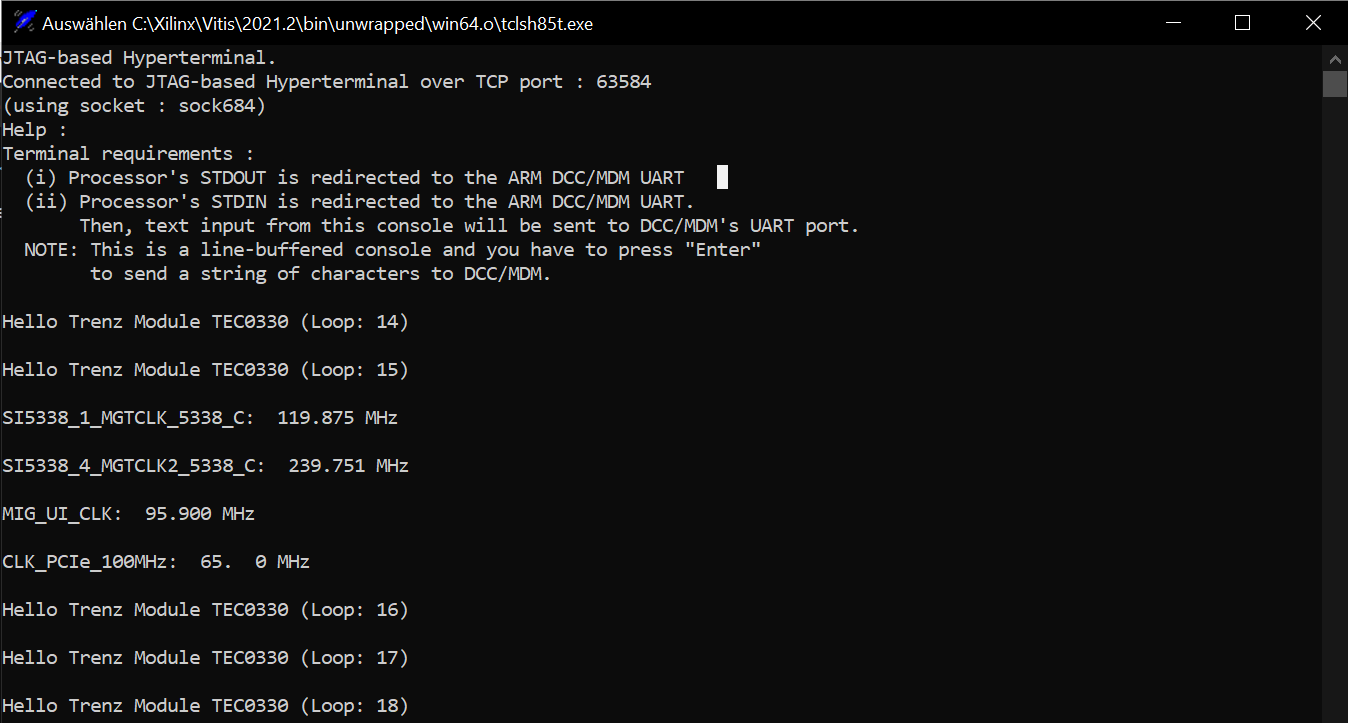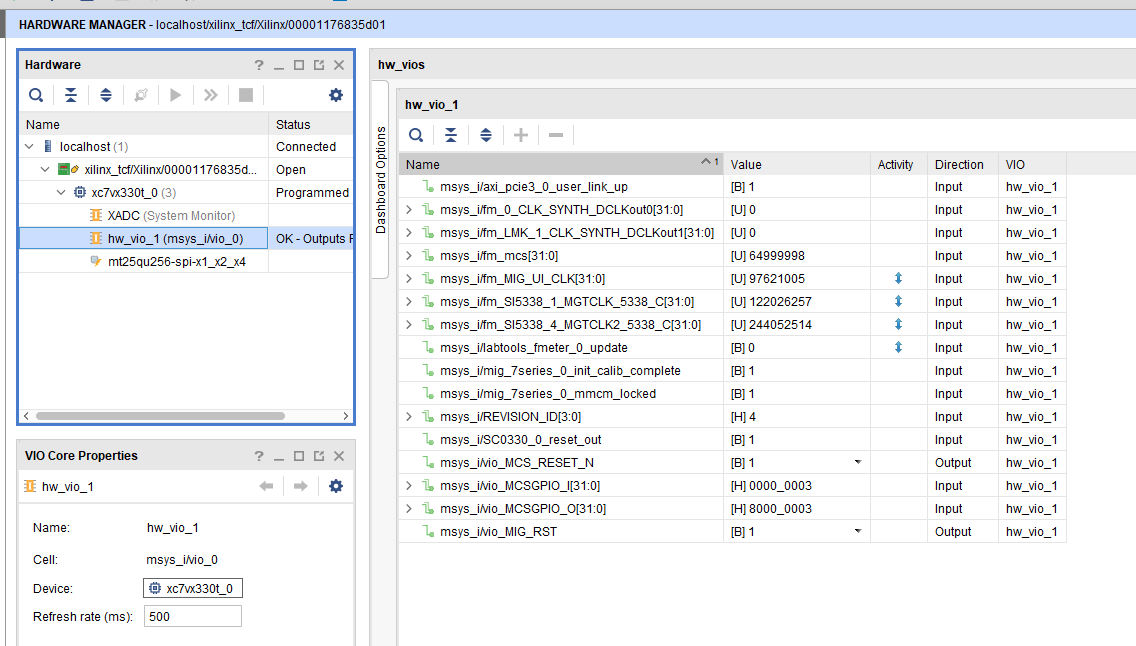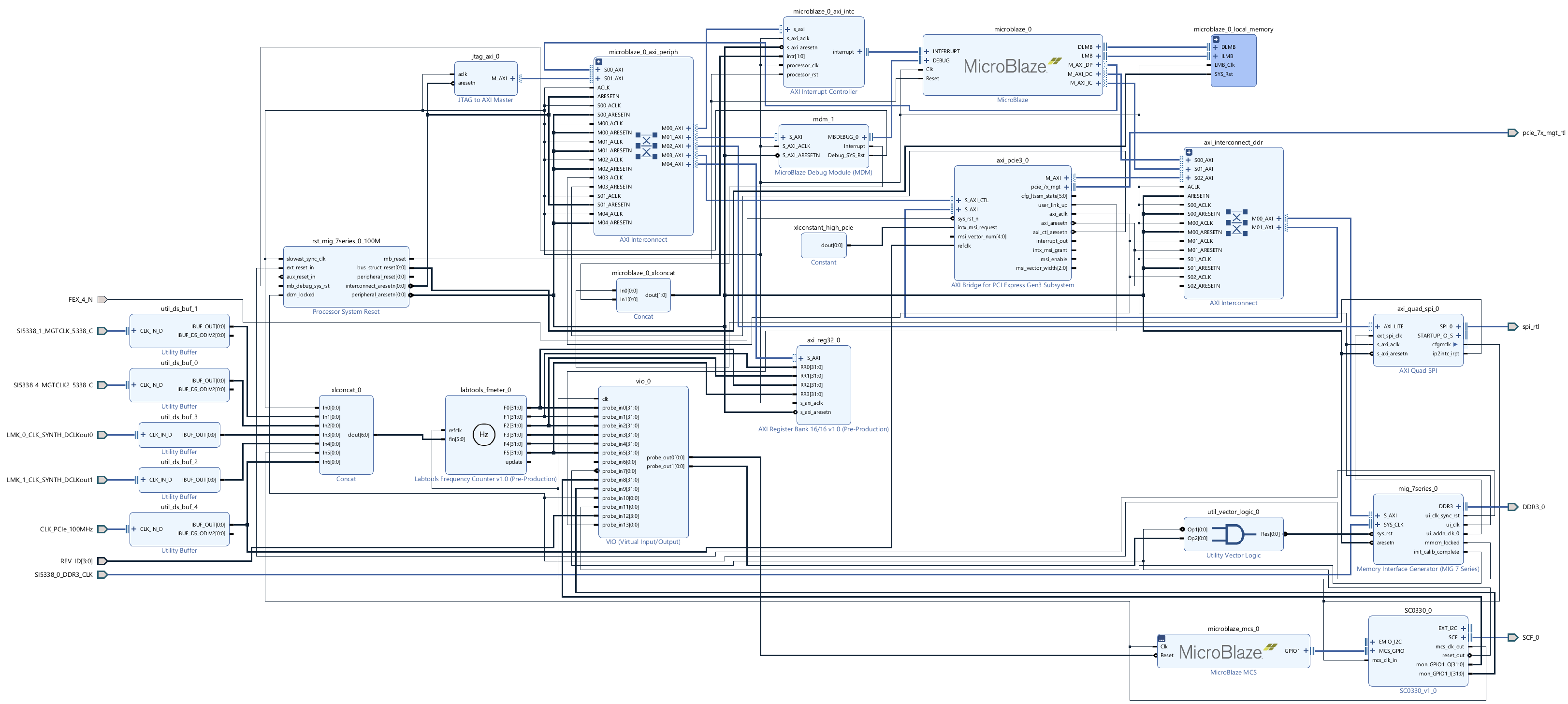- Created by John Hartfiel, last modified by Waldemar Hanemann on 26 09, 2022
Overview
This TEC0330 reference design implements the SI5338 Configuration, DDR Configuration and PCIe Core Example Design.
Refer to http://trenz.org/tec0330-info for the current online version of this manual and other available documentation.
Key Features
- Vitis/Vivado 2021.2
- MicroBlaze
- SPI ELF Bootloader
- I2C
- Flash
- MIG
- FMeter
- SI5338 initialisation with MCS
- PCIe
- DDR3 ECC SODIMM (currently ECC disabled)
Revision History
| Date | Vivado | Project Built | Authors | Description |
|---|---|---|---|---|
| 2022-09-22 | 2021.2 | TEC0330-test_board_noprebuilt-vivado_2021.2-build_17_20220922155804.zip TEC0330-test_board-vivado_2021.2-build_17_20220922155804.zip | Waldemar Hanemann |
|
| 2018-10-30 | 2018.2 | TEC0330-test_board_noprebuilt-vivado_2018.2-build_03_20181030122205.zip TEC0330-test_board-vivado_2018.2-build_03_20181030122147.zip | John Hartfiel |
|
Release Notes and Know Issues
| Issues | Description | Workaround | To be fixed version |
|---|---|---|---|
| DDR3 ECC SODIMM | DDR3 does not work with ECC enabled | Disable ECC:
| --- |
Requirements
Software
| Software | Version | Note |
|---|---|---|
| Vitis | 2021.2 | needed, Vivado is included into Vitis installation |
| Clockbuilder Pro | 4.5(used in this design) | optional |
Hardware
Basic description of TE Board Part Files is available on TE Board Part Files.
Complete List is available on <design name>/board_files/*_board_files.csv
Design supports following modules:
| Module Model | Board Part Short Name | PCB Revision Support | DDR | QSPI Flash | Others | Notes |
|---|---|---|---|---|---|---|
| TEC0330-04-(330-2C) | 330_2 | REV04 | DDR3 ECC SODIMM | 32MB |
| |
| TEC0330-05 | 330_2 | REV05 | DDR3 ECC SODIMM | 32MB |
| |
| TEC0330-05-S | 330_2 | REV05 | DDR3 ECC SODIMM | 32MB |
|
Design supports following carriers:
| Carrier Model | Notes |
|---|---|
| PC with PCIe Card slot | Card need 3.3V from PCIe and 12V from ATX connector |
Additional HW Requirements:
| Additional Hardware | Notes |
|---|---|
| JTAG Programmer |
|
| DDR3 (204 Pin with ECC) |
|
Content
For general structure and of the reference design, see Project Delivery - AMD devices
Design Sources
| Type | Location | Notes |
|---|---|---|
| Vivado | <project folder>\block_design <project folder>\constraints <project folder>\ip_lib <project folder>\board_files | Vivado Project will be generated by TE Scripts |
| Vitis | <project folder>\sw_lib | Additional Software Template for Vitis and apps_list.csv with settings automatically for Vitis app generation |
Additional Sources
| Type | Location | Notes |
|---|---|---|
SI5338 | <project folder>/misc/Si5338 | SI5338 Project with current PLL Configuration |
Prebuilt
File | File-Extension | Description |
|---|---|---|
| BIT-File | *.bit | FPGA (PL Part) Configuration File |
| DebugProbes-File | *.ltx | Definition File for Vivado/Vivado Labtools Debugging Interface |
| Diverse Reports | --- | Report files in different formats |
| Hardware-Platform-Specification-Files | *.xsa | Exported Vivado hardware description file for Vitis and PetaLinux |
| LabTools Project-File | *.lpr | Vivado Labtools Project File |
MCS-File | *.mcs | Flash Configuration File with Boot-Image (MicroBlaze or FPGA part only) |
MMI-File | *.mmi | File with BRAM-Location to generate MCS or BIT-File with *.elf content (MicroBlaze only) |
| Software-Application-File | *.elf | Software Application for Zynq or MicroBlaze Processor Systems |
Download
Reference Design is only usable with the specified Vivado/Vitis/PetaLinux version. Do never use different Versions of Xilinx Software for the same Project.
Reference Design is available on:
Design Flow
Reference Design is available with and without prebuilt files. It's recommended to use TE prebuilt files for first lunch.
See also: AMD Development Tools#XilinxSoftware-BasicUserGuides
The Trenz Electronic FPGA Reference Designs are TCL-script based project. Command files for execution will be generated with "_create_win_setup.cmd" on Windows OS and "_create_linux_setup.sh" on Linux OS.
TE Scripts are only needed to generate the vivado project, all other additional steps are optional and can also executed by Xilinx Vivado/Vitis GUI. For currently Scripts limitations on Win and Linux OS see: Project Delivery Currently limitations of functionality
Caution! Win OS has a 260 character limit for path lengths which can affect the Vivado tools. To avoid this issue, use Virtual Drive or the shortest possible names and directory locations for the reference design (for example "x:\<project folder>")
Run _create_win_setup.cmd/_create_linux_setup.sh and follow instructions on shell:
_create_win_setup.cmd/_create_linux_setup.sh------------------------Set design paths---------------------------- -- Run Design with: _create_win_setup -- Use Design Path: <absolute project path> -------------------------------------------------------------------- -------------------------TE Reference Design--------------------------- -------------------------------------------------------------------- -- (0) Module selection guide, project creation...prebuilt export... -- (1) Create minimum setup of CMD-Files and exit Batch -- (2) Create maximum setup of CMD-Files and exit Batch -- (3) (internal only) Dev -- (4) (internal only) Prod -- (c) Go to CMD-File Generation (Manual setup) -- (d) Go to Documentation (Web Documentation) -- (g) Install Board Files from Xilinx Board Store (beta) -- (a) Start design with unsupported Vivado Version (beta) -- (x) Exit Batch (nothing is done!) ---- Select (ex.:'0' for module selection guide):
Press 0 and enter to start "Module Selection Guide"
- (optional Win OS) Generate Virtual Drive or use short directory for the reference design (for example x:\<design name>)
- Create project and follow instructions of the product selection guide, settings file will be configured automatically during this process.
optional for manual changes: Select correct device and Xilinx install path on "design_basic_settings.cmd" and create Vivado project with "vivado_create_project_guimode.cmd"
Note: Select correct one, see also Vivado Board Part Flow
Create hardware description file (.xsa file) for PetaLinux project and export to prebuilt folder
run on Vivado TCL (Script generates design and export files into "<project folder>\prebuilt\hardware\<short name>")TE::hw_build_design -export_prebuilt
Using Vivado GUI is the same, except file export to prebuilt folder.
Generate Programming Files with Vitis
run on Vivado TCL (Script generates applications and bootable files, which are defined in "test_board\sw_lib\apps_list.csv")TE::sw_run_vitis -all TE::sw_run_vitis (optional; Start Vitis from Vivado GUI or start with TE Scripts on Vivado TCL)
TCL scripts generate also platform project, this must be done manually in case GUI is used. See Vitis
(Optional) BlockRam Firmware Update
Copy "<project folder>\prebuilt\software\<short name>\spi_bootloader.elf" into "<project folder>\firmware\microblaze_0\"
Copy "<project folder>\workspace\sdk\scu\Release\scu.elf" into "\firmware\microblaze_mcs_0\"
Regenerate Vivado Project or Update Bitfile only with "spi_bootloader.elf" and "scu_te0712.elf"
TE::hw_build_design -export_prebuilt TE::sw_run_vitis -all
Launch
Programming
Check Module and Carrier TRMs for proper HW configuration before you try any design.
Reference Design is also available with prebuilt files. It's recommended to use TE prebuilt files for first launch.
Xilinx documentation for programming and debugging: Vivado/Vitis/SDSoC-Xilinx Software Programming and Debugging
Get prebuilt boot binaries
- Run _create_win_setup.cmd/_create_linux_setup.sh and follow instructions on shell
- Press 0 and enter to start "Module Selection Guide"
- Select assembly version
- Validate selection
Select create and open delivery binary folder
Note: Folder "<project folder>\_binaries_<Article Name>" with subfolder "boot_<app name>" for different applications will be generate
QSPI-Boot mode
- Connect JTAG and Power ON PC
- Open Vivado Project with "vivado_open_existing_project_guimode.cmd" or if not created, create with "vivado_create_project_guimode.cmd"
Type on Vivado TCL Console:
run on Vivado TCL (Script programs u-boot.mcs onto QSPI flash)TE::pr_program_flash -swapp hello_tec0330
- Reboot PC
SD-Boot mode
Not used on this Example.
JTAG
- Connect Vivado HW Manager and program FPGA
Usage
- Prepare HW like described on section Programming
- Power On PCB
Note: 1. FPGA Load Bitfile into FPGA,MCS configure SI5338 and starts microblaze design, modified SPI Bootloader to load hello_tec0330 application from QSPI into DDR (Depends on linker script)
JTAG/UART Console:
- Launch XSCT or the XSDB console on Vitis:
- type: connect
- type: targets -set -filter {name =~ "MicroBlaze Debug*"} -index 0
- type: jtagterminal -start
- Separate console starts printing out four internal frequencies(can also be seen in the hardware manager) and "Hello Trenz Module" in a loop:

Vivado HW Manager:
- Open Vivado HW Manager
- Add VIO to Dashboard
- Set Radix to unsigned integer for FMeterCLKs (fm_*). Note measurement is not accurate
- Control:
- MCS Reset
- MIG Reset
- Read: SI5338 CLKs (Unit Hz), PCIe Core User Link Up signal, MIG MMCM Lock signal, MIG Init Calibration Done signal, PCB Revision ID

PC:
- Use for example PCI-Z (Win) or KInfoCenter (Linux) to detect PCIe Card

System Design - Vivado
Block Design

Constraints
Basic module constrains
# # Default common settings that do not depend assembly variant # set_property BITSTREAM.GENERAL.COMPRESS TRUE [current_design] set_property BITSTREAM.CONFIG.CONFIGRATE 66 [current_design] set_property BITSTREAM.CONFIG.SPI_32BIT_ADDR YES [current_design] set_property BITSTREAM.CONFIG.SPI_BUSWIDTH 4 [current_design] set_property BITSTREAM.CONFIG.M1PIN PULLNONE [current_design] set_property BITSTREAM.CONFIG.M2PIN PULLNONE [current_design] set_property BITSTREAM.CONFIG.M0PIN PULLNONE [current_design] set_property BITSTREAM.CONFIG.USR_ACCESS TIMESTAMP [current_design]
# # # set_property BITSTREAM.CONFIG.UNUSEDPIN PULLDOWN [current_design]
Design specific constrain
#----------
#IIC to CPLD
set_property PACKAGE_PIN W29 [get_ports SCF_0_cpld_25_scl]
set_property PACKAGE_PIN W26 [get_ports SCF_0_cpld_19_oe]
set_property PACKAGE_PIN V29 [get_ports SCF_0_cpld_24_sda]
set_property IOSTANDARD LVCMOS18 [get_ports SCF_0_cpld_25_scl]
set_property IOSTANDARD LVCMOS18 [get_ports SCF_0_cpld_19_oe]
set_property IOSTANDARD LVCMOS18 [get_ports SCF_0_cpld_24_sda]
#----------
#PCIe
set_property PACKAGE_PIN E33 [get_ports FEX_4_N]
set_property IOSTANDARD LVCMOS18 [get_ports FEX_4_N]
set_property PACKAGE_PIN AD6 [get_ports {CLK_PCIe_100MHz_clk_p[0]}]
#todo check auto placement:
set_property CLOCK_DEDICATED_ROUTE FALSE [get_nets msys_i/axi_pcie3_0/inst/pcie3_ip_i/inst/gt_top_i/pipe_wrapper_i/pipe_lane[0].gt_wrapper_i/CLK_TXOUTCLK]
#----------
#Revision ID
set_property PACKAGE_PIN AP27 [get_ports {REV_ID[0]}]
set_property PACKAGE_PIN AN27 [get_ports {REV_ID[1]}]
set_property PACKAGE_PIN AP26 [get_ports {REV_ID[2]}]
set_property PACKAGE_PIN AP25 [get_ports {REV_ID[3]}]
set_property IOSTANDARD LVCMOS18 [get_ports {REV_ID[*]}]
#----------
#QSPI
set_property PACKAGE_PIN AL33 [get_ports {spi_rtl_ss_io[0]}]
set_property IOSTANDARD LVCMOS18 [get_ports {spi_rtl_ss_io[0]}]
set_property PACKAGE_PIN AN33 [get_ports spi_rtl_io0_io]
set_property PACKAGE_PIN AN34 [get_ports spi_rtl_io1_io]
set_property PACKAGE_PIN AK34 [get_ports spi_rtl_io2_io]
set_property PACKAGE_PIN AL34 [get_ports spi_rtl_io3_io]
set_property IOSTANDARD LVCMOS18 [get_ports spi_rtl_io0_io]
set_property IOSTANDARD LVCMOS18 [get_ports spi_rtl_io1_io]
set_property IOSTANDARD LVCMOS18 [get_ports spi_rtl_io2_io]
set_property IOSTANDARD LVCMOS18 [get_ports spi_rtl_io3_io]
#----------
#CLKS
##SI5338_0_DDR3_CLK #diff 1.5V AG17/AH17
set_property PACKAGE_PIN AG17 [get_ports {SI5338_0_DDR3_CLK_clk_p}]
set_property IOSTANDARD DIFF_SSTL15 [get_ports {SI5338_0_DDR3_CLK_clk_p}]
##SI5338_1_MGTCLK_5338_C #diff MGT 1.8V AB6/AB5
set_property PACKAGE_PIN AB6 [get_ports {SI5338_1_MGTCLK_5338_C_clk_p[0]}]
###SI5338_3_LMK_CLK #diff MGT 1.8V to LMK CLKin1
##SI5338_4_MGTCLK2_5338_C #diff MGT 1.8V H6/H5
set_property PACKAGE_PIN H6 [get_ports {SI5338_4_MGTCLK2_5338_C_clk_p[0]}]
##LMK_0_CLK_SYNTH_DCLKout0 #diff 1.8V AD29/AE29
set_property PACKAGE_PIN AD29 [get_ports {LMK_0_CLK_SYNTH_DCLKout0_clk_p[0]}]
set_property IOSTANDARD LVDS [get_ports {LMK_0_CLK_SYNTH_DCLKout0_clk_p[0]}]
set_property DIFF_TERM TRUE [get_ports {LMK_0_CLK_SYNTH_DCLKout0_clk_p[0]}]
##LMK_1_CLK_SYNTH_DCLKout1 #diff 1.8V AE31/AF31
set_property PACKAGE_PIN AE31 [get_ports {LMK_1_CLK_SYNTH_DCLKout1_clk_p[0]}]
set_property IOSTANDARD LVDS [get_ports {LMK_1_CLK_SYNTH_DCLKout1_clk_p[0]}]
set_property DIFF_TERM TRUE [get_ports {LMK_1_CLK_SYNTH_DCLKout1_clk_p[0]}]
###LMK_2_CLKIN_5338_P #diff 1.8Vto Si5338 IN1/IN2
###LMK_3_CLK_SYNTH_SDCLKout3 #diff 1.8Vto N.C.
###LMK_4_CLK_SYNTH_SDCLKout4 #diff MGT 1.8V T6/T5
###LMK_5_CLK_SYNTH_SDCLKout5 #diff 1.8Vto N.C.
###LMK_6_CLK_SYNTH_SDCLKout6 #diff 1.8Vto N.C.
###LMK_7_CLK_SYNTH_SDCLKout7 #diff MGT 1.8V F6/F5
###LMK_8_CLK_SYNTH_SDCLKout8 #diff 1.8Vto N.C.
###LMK_9_CLK_SYNTH_SDCLKout9 #diff 1.8Vto N.C.
###LMK_10_CLK_SYNTH_SDCLKout10 #diff 1.8Vto N.C.
###LMK_11_CLK_SYNTH_SDCLKout11 #diff 1.8Vto N.C.
###LMK_12_CLK_SYNTH_SDCLKout12 #diff 1.8Vto N.C.
###LMK_13_CLK_SYNTH_SDCLKout13 #diff 1.8Vto N.C.
#----------
Software Design - Vitis
For Vitis project creation, follow instructions from:
Application
Template location: ./sw_lib/sw_apps/
hello_tec0330
- Hello World as endless loop with output of four frequencies.
scu
- Si5338 I2C Configuration via MicroBlaze MCS.
spi_bootloader
TE modified SPI Bootloader from Henrik Brix Andersen.
Bootloader to load app or second bootloader from flash into DDR.
Here it loads the u-boot.elf from QSPI-Flash to RAM. Hence u-boot.srec becomes redundant.
Descriptions:
- Modified Files: bootloader.c
- Changes:
- Change the SPI defines in the header
- Add some reiteration in the frist spi read call
Additional Software
SI5338
File location "<project folder>\misc\Si5338\Si5338-*.slabtimeproj"
General documentation how you work with this project will be available on Si5338
Appx. A: Change History and Legal Notices
Document Change History
To get content of older revision got to "Change History" of this page and select older document revision number.
| Date | Document Revision | Authors | Description |
|---|---|---|---|
Error rendering macro 'page-info' Ambiguous method overloading for method jdk.proxy241.$Proxy3497#hasContentLevelPermission. Cannot resolve which method to invoke for [null, class java.lang.String, class com.atlassian.confluence.pages.Page] due to overlapping prototypes between: [interface com.atlassian.confluence.user.ConfluenceUser, class java.lang.String, class com.atlassian.confluence.core.ContentEntityObject] [interface com.atlassian.user.User, class java.lang.String, class com.atlassian.confluence.core.ContentEntityObject] | Error rendering macro 'page-info' Ambiguous method overloading for method jdk.proxy241.$Proxy3497#hasContentLevelPermission. Cannot resolve which method to invoke for [null, class java.lang.String, class com.atlassian.confluence.pages.Page] due to overlapping prototypes between: [interface com.atlassian.confluence.user.ConfluenceUser, class java.lang.String, class com.atlassian.confluence.core.ContentEntityObject] [interface com.atlassian.user.User, class java.lang.String, class com.atlassian.confluence.core.ContentEntityObject] | Error rendering macro 'page-info' Ambiguous method overloading for method jdk.proxy241.$Proxy3497#hasContentLevelPermission. Cannot resolve which method to invoke for [null, class java.lang.String, class com.atlassian.confluence.pages.Page] due to overlapping prototypes between: [interface com.atlassian.confluence.user.ConfluenceUser, class java.lang.String, class com.atlassian.confluence.core.ContentEntityObject] [interface com.atlassian.user.User, class java.lang.String, class com.atlassian.confluence.core.ContentEntityObject] |
|
| 2018-10-32 | John Hartfiel |
| |
| -- | all | Error rendering macro 'page-info' Ambiguous method overloading for method jdk.proxy241.$Proxy3497#hasContentLevelPermission. Cannot resolve which method to invoke for [null, class java.lang.String, class com.atlassian.confluence.pages.Page] due to overlapping prototypes between: [interface com.atlassian.confluence.user.ConfluenceUser, class java.lang.String, class com.atlassian.confluence.core.ContentEntityObject] [interface com.atlassian.user.User, class java.lang.String, class com.atlassian.confluence.core.ContentEntityObject] | -- |
Legal Notices
Data Privacy
Please also note our data protection declaration at https://www.trenz-electronic.de/en/Data-protection-Privacy
Document Warranty
The material contained in this document is provided “as is” and is subject to being changed at any time without notice. Trenz Electronic does not warrant the accuracy and completeness of the materials in this document. Further, to the maximum extent permitted by applicable law, Trenz Electronic disclaims all warranties, either express or implied, with regard to this document and any information contained herein, including but not limited to the implied warranties of merchantability, fitness for a particular purpose or non infringement of intellectual property. Trenz Electronic shall not be liable for errors or for incidental or consequential damages in connection with the furnishing, use, or performance of this document or of any information contained herein.
Limitation of Liability
In no event will Trenz Electronic, its suppliers, or other third parties mentioned in this document be liable for any damages whatsoever (including, without limitation, those resulting from lost profits, lost data or business interruption) arising out of the use, inability to use, or the results of use of this document, any documents linked to this document, or the materials or information contained at any or all such documents. If your use of the materials or information from this document results in the need for servicing, repair or correction of equipment or data, you assume all costs thereof.
Copyright Notice
No part of this manual may be reproduced in any form or by any means (including electronic storage and retrieval or translation into a foreign language) without prior agreement and written consent from Trenz Electronic.
Technology Licenses
The hardware / firmware / software described in this document are furnished under a license and may be used /modified / copied only in accordance with the terms of such license.
Environmental Protection
To confront directly with the responsibility toward the environment, the global community and eventually also oneself. Such a resolution should be integral part not only of everybody's life. Also enterprises shall be conscious of their social responsibility and contribute to the preservation of our common living space. That is why Trenz Electronic invests in the protection of our Environment.
REACH, RoHS and WEEE
REACH
Trenz Electronic is a manufacturer and a distributor of electronic products. It is therefore a so called downstream user in the sense of REACH. The products we supply to you are solely non-chemical products (goods). Moreover and under normal and reasonably foreseeable circumstances of application, the goods supplied to you shall not release any substance. For that, Trenz Electronic is obliged to neither register nor to provide safety data sheet. According to present knowledge and to best of our knowledge, no SVHC (Substances of Very High Concern) on the Candidate List are contained in our products. Furthermore, we will immediately and unsolicited inform our customers in compliance with REACH - Article 33 if any substance present in our goods (above a concentration of 0,1 % weight by weight) will be classified as SVHC by the European Chemicals Agency (ECHA).
RoHS
Trenz Electronic GmbH herewith declares that all its products are developed, manufactured and distributed RoHS compliant.
WEEE
Information for users within the European Union in accordance with Directive 2002/96/EC of the European Parliament and of the Council of 27 January 2003 on waste electrical and electronic equipment (WEEE).
Users of electrical and electronic equipment in private households are required not to dispose of waste electrical and electronic equipment as unsorted municipal waste and to collect such waste electrical and electronic equipment separately. By the 13 August 2005, Member States shall have ensured that systems are set up allowing final holders and distributors to return waste electrical and electronic equipment at least free of charge. Member States shall ensure the availability and accessibility of the necessary collection facilities. Separate collection is the precondition to ensure specific treatment and recycling of waste electrical and electronic equipment and is necessary to achieve the chosen level of protection of human health and the environment in the European Union. Consumers have to actively contribute to the success of such collection and the return of waste electrical and electronic equipment. Presence of hazardous substances in electrical and electronic equipment results in potential effects on the environment and human health. The symbol consisting of the crossed-out wheeled bin indicates separate collection for waste electrical and electronic equipment.
Trenz Electronic is registered under WEEE-Reg.-Nr. DE97922676.
Error rendering macro 'page-info'
Ambiguous method overloading for method jdk.proxy241.$Proxy3497#hasContentLevelPermission. Cannot resolve which method to invoke for [null, class java.lang.String, class com.atlassian.confluence.pages.Page] due to overlapping prototypes between: [interface com.atlassian.confluence.user.ConfluenceUser, class java.lang.String, class com.atlassian.confluence.core.ContentEntityObject] [interface com.atlassian.user.User, class java.lang.String, class com.atlassian.confluence.core.ContentEntityObject]
Table of contents
- No labels